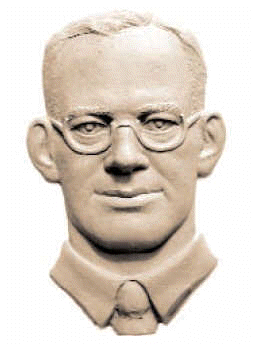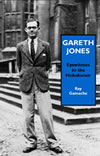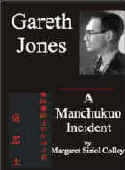Gareth Jones
[bas relief by Oleh Lesiuk]
HOME |
Stop Press |
Complete Soviet Articles & Background Information |
Précis of Gareth's
|
All Published Articles |
BOOKS
|
|
|
|
More Than Grain of Truth(2005) |
|
|
TOPICAL
'Are you Listening NYT?' U.N. Speech - Nov 2009 |
Gareth Recognised at Cambridge - Nov 2009 |
Reporter and the Genocide - Rome, March 2009 |
Order of Freedom Award -Nov 2008 |
Premiere of 'The Living' Documentary Kyiv - Nov 2008 |
Gareth Jones 'Famine' Diaries - Chicago 2008 |
Aberystwyth Memorial Plaque 2006 |
GENERAL
Scholarship Fund |
Site Map |
Links |
Legal Notices |
Sponsored Links |
Contact |
The Reporter and the Genocide:
Gareth Jones and the Ukrainian famine of 1932-33
At the Guarini Institute for Public Affairs
Friday March 13th 2009
For Delegates' Biographies please CLICK HERE
Morning session (Chair: Federigo Argentieri, director, Guarini Institute for Public Affairs)
• 10:00 am Welcoming addresses
by JCU President Franco Pavoncello, Fondazione Liberal and H.E. Heorhii Chernyavskyi, Ambassador of Ukraine to Italy
• 10:30 am Ukraine Between Stalin and Hitler
Karel C. Berkhoff, Centre for Holocaust and Genocide Studies, Royal Netherlands Academy of Arts and Sciences
• 11:15 am Holodomor: Facts and Interpretations
Ettore Cinnella, University of Pisa
• 12:00 am Gareth Jones: a Forgotten Hero?
Nigel Linsan Colley (UK) - CLICK HERE for PowerPoint Presentation.
• Discussion
Afternoon session
• 4:00 pm Silence that Speaks Volumes. Holodomor in Ukrainian and Soviet Film
Yuri Shevchuk, Columbia University
• 5:00 pm Screening of the film
“The Living” with Serhii Bukovsky , director & Victotia Bondar, co-screenwriter.For the John Cabot University's ,Guarini Institute of Public Affairs' online review of the Conference, by Silvia Cavasola, then please CLICK HERE [or see transcript below the photographs underneath.]
Personal Photos below by Nigel Colley - Click on Thumbnails below for larger pictures
Personal Photos by Nigel Colley
John Cabot University's, Guarini Institute of Public Affairs' online review of the Conference
by Silvia Cavasola
Friday, March 13th, 2009 10am to 7pm
Aula Magna Regina
Guarini Institute Panel and Film Screening
"The Reporter and the Genocide: Gareth Jones and the Ukrainian Famine of
1932-33"
The Guarini Institute conference hosted by John Cabot
University and co-sponsored by Fondazione Liberal focused on different aspects
of the Ukrainian Famine of 1932-1933. The morning section opened with a
welcoming speech by JCU President Franco Pavoncello, and by the Ukrainian
Ambassador to Rome, Mr. Heorhii Chernyavskyi. Then the panel discussion begun,
with a speech by Dr. Karel C. Berkhoff entitled "Ukraine between Stalin and
Hitler." Educated in Amsterdam, at Harvard University (AM), and at the
University of Toronto (1998), Dr. Berkhoff is an historian who since 2003 has
been working as a researcher and an associate professor at the Center for
Holocaust and Genocide Studies, an organization of the Royal Netherlands Academy
of Arts and Sciences and the University of Amsterdam. His book Harvest of
Despair: Life and Death in Ukraine under Nazi Rule (Harvard University Press,
2004, paperback 2008) was awarded the Wiener Library's Fraenkel Prize in
Contemporary History. His current research focuses on Soviet war propaganda and
on sites of Nazi and Soviet mass murder in and near Kiev.
The floor was then passed to Ettore Cinnella, professor of History at the
University of Pisa, whose research is focused on Russia and Ukraine before and
during the Soviet period. He has published, among others, studies on Ukraine and
the anarchist movement during the 1917-1921 turmoil. His presentation described
the different and sometimes contrasting interpretations of the Holodomor carried
out by international scholars and historians: he shed an important light on the
problems regarding the acknowledgments of the causes and consequences of the
great Ukrainian famine of 1932-1933. The morning session eventually featured a
remarkable presentation by Nigel Linsan Colley. The great nephew of Gareth
Jones, the long-forgotten Welsh journalist who covered and exposed the tragedy
of Holodomor, Mr. Colley went over the life and career of his great uncle
through the exposition of his diaries, which today represent an invaluable
source of documentation over the Soviet policies that led to the tragic events
of the Ukrainian Famine in the early thirties. Having travelled across the
Ukrainian countryside during the periods of the great famine, the young
journalist had reported on the horrifying living conditions of the Ukrainian
peasants at a time when Soviet authorities, under Stalin, were carrying out the
famous five-year plan for agricultural collectivization. The presentation ended
with a discussion over the mysterious causes of the death of the reporter, who
was killed by Chinese bandits in 1935 after having uncovered the uncomfortable
realities of Soviet policies in Ukraine.
After a lunch break, the afternoon session began with a brief address by
Ambassador Giacomo Attolico (ret.), whose father, Bernardo, had represented the
Kingdom of Italy to Moscow in 1930-35 and, along with Kharkiv consul Sergio
Gradenigo, had described in great detail the tragedy of Ukraine: their reports
and dispatches had been buried in the archives of Farnesina (the Italian Foreign
Ministry) until a Basilian priest, father Porfiriy Pidruchnyi (who also attended
the conference), discovered them in the 1970's. Next came a presentation by Dr.
Yuri Shevchuk, who spoke about the representation of Holodomor by Ukrainian and
Soviet cinema. With a Ph.D. in Germanic Languages (Kyiv State University, 1987),
Dr Shevchuk is lecturer in the Ukrainian Language and Culture Department of
Slavic Languages and the Harriman Institute at Columbia University. The founding
director of the Ukrainian Film Club of Columbia University, he will soon have
his article on "Linguistic Strategies of Imperial Appropriation" published in
the collective monograph Ukraine on the Cultural Map of Europe, Sharp, April
2009. By illustrating the history of Soviet and Ukrainian cinema during the
periods before, during and after the Holodomor, Dr. Shevchuk discussed the role
played by cinema in silencing the horrifying realities of the great Ukrainian
Famine.
The last part of the conference was dedicated to the screening of the
documentary "he Living. Produced in 2008, the documentary was realized by
outstanding Ukrainian director Serhii Bukovsky, and John Cabot University had
the honor of hosting the European premiere. Shown in original language with
English subtitles, it featured a collection of testimonies of those who survived
the Holodomor. Coupling artistic merit with invaluable historical documents, the
documentary was greatly successful among the audience, which then had the
opportunity to discuss it with the director himself and with the producer,
Victoria Bondar, who were both present at the conference.
By Silvia Cavasola













![Yuri Shevchuk & Silvia Cavasola [Guarini Institute]](photogallery/photo00000041/IMG_3958.jpg)



